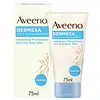What's inside
What's inside
 Key Ingredients
Key Ingredients

 Benefits
Benefits

 Concerns
Concerns

 Ingredients Side-by-side
Ingredients Side-by-side

Glycerin
HumectantWater
Skin ConditioningCetearyl Alcohol
EmollientIsocetyl Alcohol
EmollientDimethicone
EmollientCetyl Alcohol
EmollientAvena Sativa Kernel Flour
AbrasiveAvena Sativa Kernel Extract
AbrasiveAvena Sativa Kernel Oil
Skin ConditioningCaprylic/Capric Triglyceride
MaskingCeramide 3
Skin ConditioningEthylhexylglycerin
Skin ConditioningP-Anisic Acid
MaskingSodium Cetearyl Sulfate
CleansingPalmitic Acid
EmollientStearic Acid
CleansingSodium Sulfate
Sodium Chloride
MaskingCitric Acid
BufferingDipotassium Phosphate
BufferingPotassium Phosphate
BufferingSodium Hydroxide
BufferingTocopherol
AntioxidantBenzyl Alcohol
PerfumingBenzoic Acid
MaskingPotassium Sorbate
PreservativeGlycerin, Water, Cetearyl Alcohol, Isocetyl Alcohol, Dimethicone, Cetyl Alcohol, Avena Sativa Kernel Flour, Avena Sativa Kernel Extract, Avena Sativa Kernel Oil, Caprylic/Capric Triglyceride, Ceramide 3, Ethylhexylglycerin, P-Anisic Acid, Sodium Cetearyl Sulfate, Palmitic Acid, Stearic Acid, Sodium Sulfate, Sodium Chloride, Citric Acid, Dipotassium Phosphate, Potassium Phosphate, Sodium Hydroxide, Tocopherol, Benzyl Alcohol, Benzoic Acid, Potassium Sorbate
Petrolatum 46.5%
EmollientParaffinum Liquidum
EmollientParaffin
PerfumingOzokerite
Emulsion StabilisingDimethicone
EmollientCeramide NP
Skin ConditioningCeramide AP
Skin ConditioningCeramide EOP
Skin ConditioningCarbomer
Emulsion StabilisingWater
Skin ConditioningSodium Lauroyl Lactylate
EmulsifyingProline
Skin ConditioningCholesterol
EmollientPhenoxyethanol
PreservativeTocopheryl Acetate
AntioxidantTocopherol
AntioxidantHydrolyzed Hyaluronic Acid
HumectantPanthenol
Skin ConditioningPantolactone
HumectantPhytosphingosine
Skin ConditioningXanthan Gum
EmulsifyingEthylhexylglycerin
Skin ConditioningPetrolatum 46.5%, Paraffinum Liquidum, Paraffin, Ozokerite, Dimethicone, Ceramide NP, Ceramide AP, Ceramide EOP, Carbomer, Water, Sodium Lauroyl Lactylate, Proline, Cholesterol, Phenoxyethanol, Tocopheryl Acetate, Tocopherol, Hydrolyzed Hyaluronic Acid, Panthenol, Pantolactone, Phytosphingosine, Xanthan Gum, Ethylhexylglycerin
 Reviews
Reviews

Ingredients Explained
These ingredients are found in both products.
Ingredients higher up in an ingredient list are typically present in a larger amount.
Dimethicone is a type of synthetic silicone created from natural materials such as quartz.
What it does:
Dimethicone comes in different viscosities:
Depending on the viscosity, dimethicone has different properties.
Ingredients lists don't always show which type is used, so we recommend reaching out to the brand if you have questions about the viscosity.
This ingredient is unlikely to cause irritation because it does not get absorbed into skin. However, people with silicone allergies should be careful about using this ingredient.
Note: Dimethicone may contribute to pilling. This is because it is not oil or water soluble, so pilling may occur when layered with products. When mixed with heavy oils in a formula, the outcome is also quite greasy.
Learn more about DimethiconeEthylhexylglycerin (we can't pronounce this either) is commonly used as a preservative and skin softener. It is derived from glyceryl.
You might see Ethylhexylglycerin often paired with other preservatives such as phenoxyethanol. Ethylhexylglycerin has been found to increase the effectiveness of these other preservatives.
Tocopherol (also known as Vitamin E) is a common antioxidant used to help protect the skin from free-radicals and strengthen the skin barrier. It's also fat soluble - this means our skin is great at absorbing it.
Vitamin E also helps keep your natural skin lipids healthy. Your lipid skin barrier naturally consists of lipids, ceramides, and fatty acids. Vitamin E offers extra protection for your skin’s lipid barrier, keeping your skin healthy and nourished.
Another benefit is a bit of UV protection. Vitamin E helps reduce the damage caused by UVB rays. (It should not replace your sunscreen). Combining it with Vitamin C can decrease sunburned cells and hyperpigmentation after UV exposure.
You might have noticed Vitamin E + C often paired together. This is because it is great at stabilizing Vitamin C. Using the two together helps increase the effectiveness of both ingredients.
There are often claims that Vitamin E can reduce/prevent scarring, but these claims haven't been confirmed by scientific research.
Learn more about TocopherolWater. It's the most common cosmetic ingredient of all. You'll usually see it at the top of ingredient lists, meaning that it makes up the largest part of the product.
So why is it so popular? Water most often acts as a solvent - this means that it helps dissolve other ingredients into the formulation.
You'll also recognize water as that liquid we all need to stay alive. If you see this, drink a glass of water. Stay hydrated!
Learn more about Water